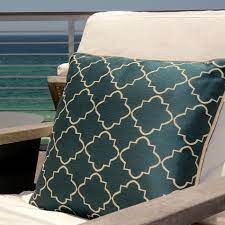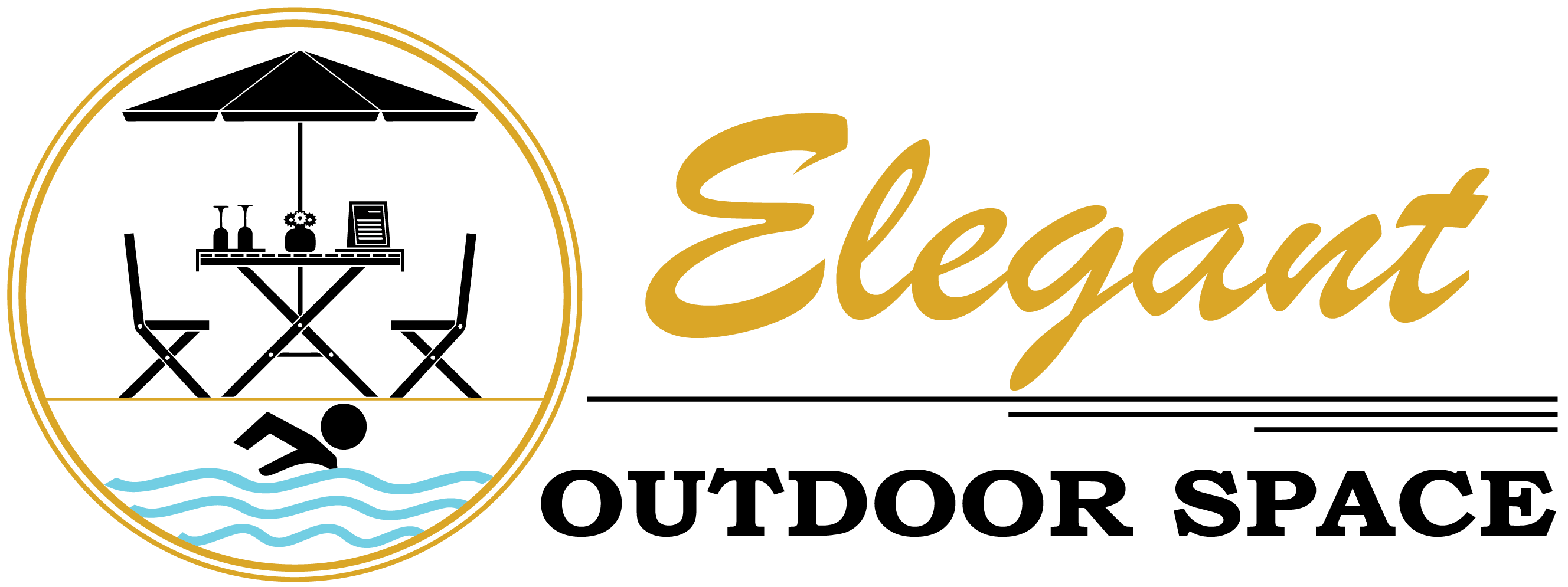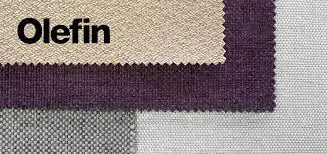Last updated on July 27th, 2022
What is the best fabric for outdoor furniture? This is the question most people ask when shopping for cushions, bean bags, or some other fabric for patio furniture. The answer you’ll frequently stumble across is “Sunbrella,” which may not come as a surprise since it’s the most popular outdoor fabric. But there are other great options – the top on the list is Olefin fabric.Olefin and Sunbrella are similar in several ways and can always be used interchangeably-they are both easy to clean, stylish, stain resistant, and comfortable. However, there are slight differences between the two fabrics. In this post, we compare Olefin vs Sunbrella fabric to identify which is the best for outdoor furniture. Read on to understand individual pros and cons so you can have a conclusive idea of what is the best fabric for outdoor furniture.
This leads us to the question – Olefin fabrics vs Sunbrella fabrics, which wins? Both materials are similar in many ways and can even be substituted in many cases – they are both stylish, comfortable, easy to clean, water and stain resistant, and durable. The major difference lies in their manufacturing process, cost, and maintenance. Your purpose and location will ultimately be the key factors in determining which one you eventually end up with.
To help you make an informed decision, we will compare both materials and see how they stack up against each other then you decide which one is the best fabric for outdoor cushions, or the best UV resistant outdoor fabric.
Table of Contents
Understanding Olefin outdoor fabric.
Like Sunbrella, Olefin is a brand name that refers to fabrics manufactured from polypropylene or polyethylene (olefin fibers). It is soft, lightweight, eco-friendly, and has a suave texture.
The major highlight of Olefin fabric is its environmental friendliness and low manufacturing cost. In fact, it’s cheaper to make than Sunbrella and many other solution dyed acrylic outdoor fabrics.
Some of the common uses include vehicle interiors, umbrella canvas, ropes, bean bags, olefin cushions, and carpets.
How are the fibers made?
Like Sunbrella acrylic, Olefin is a synthetic fabric. It is made by polymerizing two gases (propylene and ethylene) to form olefin fibers.

This usually involves melting the gases into liquid using special catalysts. Next, they are fed through tiny holes in a spinneret machine to form long-length fibers.
Olefin fibers are difficult to dye once they’ve been formed, so it’s solution-dyed. This means that the polymers are mixed with the colors being woven into yarns. This also makes them fade resistant, which is why they don’t lose their colors.
So, both Olefin and Sunbrella are made from solution-dyed yarns. The key difference is the starting material. While Olefin is derived from polyolefin fibers, Sunbrella is made from acrylic yarns and they pass through the manufacturing process in a similar way.
Olefin fibers were first developed in 1957 by an Italian chemist, Giulio Natta. Today, it accounts for over 16 percent of the world’s total fibers in production.
Pros
Here are the major benefits of using Olefin fabric and not Sunbrella:
Cheaper: Compared to Sunbrella and similar fabrics, Olefin is generally cheaper. The lower cost is linked to the manufacturing process, which is widely available and more affordable than that of Sunbrella and others.
Eco-friendly: The production of olefin results in very little byproduct, which means less waste is created. Also, olefin fibers are completely recyclable and can be re-extruded over ten times to form new products.
Smooth to touch: As earlier indicated, Olefin fabrics have a suave texture, which makes them very smooth to touch. This, combined with its softness, makes it quite comfortable. It is these properties that make it ideal for use in vehicle interiors.
Water-resistant: Like Sunbrella, Olefin fabric is water-resistant. It doesn’t absorb moisture and dries quickly. This makes it an excellent choice as an outdoor fabric for areas that get a lot of rainfall. The material is also highly breathable, which means it will wick away sweat and moisture, so your cushions won’t get soaked or soggy on hot days.
Durable: Olefin is highly resistant to wear, especially abrasion. This makes it a great choice for outdoor fabric.
Colorfast: It uses solution dyeing in its production, so it’s incredibly colorfast. This means that the color is built into the core and will resist fading over time.
Versatile: Olefin is available in a wide range of colors, styles, and patterns. This opens up a lot of design possibilities. It’s nearly impossible not to find something that would match your outdoor furniture or project.
Doesn’t transmit static: This is one of the major advantages of using Olefin compared to other indoor or outdoor fabrics. Olefin materials neither hold nor transfer static electricity. Though not dangerous, static can cause discomfort when sitting on your outdoor furniture or any other charged surface during winter or when humidity is low.
Drawbacks
Olefin has a few disadvantages. The major one is its high sensitivity to heat. When exposed to high temperatures, it can melt. This is why you can’t put the material in a dryer after washing. Instead, you have to air dry it. Ironing should also be done at the lowest temperature or completely avoided to keep the fabric in good shape.
Understanding Sunbrella outdoor fabric
Sunbrella isn’t the name of fabric but a brand. The name is used for one of the more popular types of outdoor fabric – acrylic. So, the material you see being taunted as Sunbrella is actually acrylic. Since it was introduced in the 60s as the first solution-dyed acrylic fabric, it’s been used for many different things. These include bean bags, boat covers, awnings, automobile tops, indoor and outdoor furniture cushions, and others. Today, Sunbrella is prominently used for outdoor furniture.
How it’s made
Sunbrella is made just like any other solution-dyed acrylic fabric. To understand what this means, you need to know what acrylic is.

Acrylic is a synthetic (artificial) material sourced from a polymer known as polyacrylonitrile. Fabrics made from acrylic are typically soft to touch, mildew resistant, and tend to stay cool under the sun. This is why they are often used mostly as outdoor fabrics.
Before solution dyeing was applied to acrylic, it would typically fade when left in the sun for long periods.
To prevent this, color is added with extra care to the chemical before passing it through a spinneret machine to form colorfast acrylic fibers. This is quite different from the usual way color is added to most outdoor fabrics, which usually involves weaving the fabric into yarn before dyeing its color. On the other hand, with solution dye, the liquid fabric is first mixed with color before being fed into the spinneret, where it is processed into yarn. This way, the fabric is able to retain its original color over time.
Pros
Doesn’t fade easily: While not indestructible, Sunbrella can withstand a lot of hammering from the sun. Specifically, it will stay up to 1500 hours in direct sunlight before it starts showing signs of fading.
Water-resistant: Sunbrella does repel water, but only to some degree. In other words, it holds up well against moisture, but that doesn’t mean it’s waterproof! You can expect the water-resistant properties to last up to three years, after which you can apply a fabric guard.
Mold and mildew-resistant: Due to its water-resistant property, Sunbrella will also resist the growth of mold and mildew. But if you do notice mold growth (maybe from fallen leaves), you can get it off by deep cleaning with bleach and water.
Decent comfort: Sunbrella is surprisingly soft, especially when put on the scale with materials like polyester and canvas. It also remains cool to touch even when exposed to direct sunlight for a long time. This ensures you don’t get all sweaty on hot days, especially during the summer months.
UV-resistant: Sunbrella fabrics are typically laden with UV stabilizing pigments, which puts them among the UV-resistant outdoor fabrics. As a result, they are ideal for areas that get a lot of natural light. You will find being used or umbrellas, canopies, and other types of shades.
Wide variety of styles: Like olefins, Sunbrella offers a wide variety of colors, styles, and patterns to choose from. It’s nearly impossible to run out of options. This makes it easier to find a style that will match the furniture or application you want to use it for.
Easy to clean: Besides being highly durable, Sunbrella is easy to clean. You can get rid of most stains on it using soapy water. Being solution dye also means it can handle bleaching, so, for tough stains, you can deep clean it with a mixture of bleach and water.
Drawback
Despite being the most popular outdoor fabric, Sunbrella is not without any disadvantages. It’s not just pricier than Olefin; it is the most expensive material for outdoor fabrics. Also, it is not as soft as Olefin and does transmit static charges, especially during colder days, when humidity drops and the air is dry. Having said that, it is obvious the advantages far outweigh the few downsides. That is the only reason it could have remained at the top (in terms of popularity) up till today.
Olefin vs Sunbrella Side by Side Comparison
Let’s see how Olefin vs Sunbrella stacks up against each other.
Water Resistance
Both Sunbrella and Olefin are water-resistant. However, Olefin still gets the upper hand as it tends to wear less over time even when regularly subjected to saltwater (or chlorinated water).
Durability
Both fabrics are made using solution-dyed, which means they possess amazing colorfastness. This means they are fade and stain resistant and will retain their colors for many years. However, when it comes to abrasion, Olefin is superior as it is more resistant to abrasion.
Maintenance
Both Sunbrella and Olefin are very easy to maintain and are both stain-resistant. Most of the time, all you need is to wipe them down with soapy water. You can also use bleach for more tricky stains. However, as noted earlier, Olefin is heat sensitive and should be air-dried and not placed in a dryer.
Functionality
Both materials are soft to touch and quite comfortable. Also, they stay cool when left under the sun. However, when it comes to resisting static buildup, Olefin gets the upper hand. Sunbrella does transmit static electricity, especially in dry weather.
Performance
As earlier indicated, both Olefin and Sunbrella don’t absorb moisture and will wick away water and sweat. In addition, Sunbrella is also mold, mildew, and stain-resistant, and that is why it’s commonly used for awnings, boat canvas, and hot tub covers. It is also superior when it comes to heat resistance as Olefin cannot withstand extreme heat.
Weatherproof
Both Olefin and Sunbrella have UV and water protection. However, as we noted earlier, the melting factor of Olefin makes it less suitable for regions with very hot climates. Sunbrella clearly wins here!
Cost
The cost of Olefin is less than that of Sunbrella. This can be traced to their manufacturing process. The raw materials for making Olefin are more readily available which significantly lowers the cost of production. However, factors such as location and where you purchase the fabric from will influence the amount you eventually pay. While Sunbrella may be more expensive upfront, it tends to last more, especially in areas that get extreme heat. So you will not need to replace it as often as you would when using Olefin.
Environmental friendliness
If you care a lot about the environment, then Olefin would be a perfect match. This is because Olefin can be recycled up to ten times. Also, the manufacturing process has a lower carbon footprint. On the other hand, Sunbrella (acrylic) is not readily biodegradable, so it’s difficult to recycle.
Verdict – Olefin vs Sunbrella? What is the best fabric for outdoor furniture?
So, between Olefin vs Sunbrella, which one is the better fabric for your garden furniture? Well, this decision is highly subjective and depends on your purpose, location, and how much you are willing to spend.
If you’re shopping on a budget or live in a region that doesn’t get too much of sunlight, then Olefin might be a better choice since it’s cheaper.
Other the other hand, if you’re willing to pay more upfront, then Sunbrella is almost always the best option. You will get many more useful years from it.
Frequently Asked Questions.
Are Sunbrella cushions worth it?
Sunbrella fabrics have always been recognized as the best fabric for outdoor cushions. They are highly durable, fade resistant, and water resistant. Sunbrella fabrics are low on maintenance, easy to clean, and, mildew/mold resistant.
What fabric is as good as Sunbrella?
Though there are slight differences, the outdura fabrics are similar to Sunbrella. They can be used in the same areas as the Sunbrella fabrics and has different varieties too.
Is olefin fabric waterproof?
Olefin is a strong fabric that is made of polypropylene which is a common outdoor furniture cushion. Other Olefin fabric products are waterproof and can easily be cleaned down if something spills on. Most outdoor cushions are made with polypropylene because of their hard nature, as well as withstanding water and being resistant to funguses and molds.
Is olefin stain resistant?
Olefin fabrics are chemically resistant to stains, giving you no need for microbial and water repelling chemicals that can be harmful to your health.
What is the best fabric for outdoor furniture covers?
Polyester is the best material to choose when looking for the best fabric for outdoor furniture covers. It is a strong and durable material that can protect your outdoor or patio furniture from the effects of sun, rain, or snow.
Is olefin the same as polypropylene?
Olefin is a general name for polypropylene. It is a common synthetic fiber used to make several products like outdoor carpets and patio furniture covers. Typically, these terms are used synonymously in most outdoor cushions and furniture covers.

